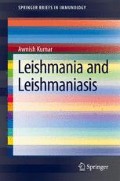Abstract
Leishmania parasite has a digenic life cycle with phlebotomine sand flies (Phlebotomus spp., Lutzomyia spp. and Psychodopygus spp.) as secondary invertebrate vector host. In the sand fly, parasites initially reside within the peritrophic membrane of the midgut after ingestion of an infected blood meal. After release from macrophages, differentiation of amastigote to promastigote occurs with concurrent synthesis of a thick glycocalyx coat composed of a variety of glycophospatidylinositol (GPI) anchor compounds. A layer of low molecular weight glycoinositol phospholipids (GIPLs) with barrier function is found below the glycocalyx. A lipophosphoglycan (LPG), containing a repeated polymer of disaccharide phosphate units, is the most abundant glycoconjugate (McConville and Ralton 1997). After 2 days, the peritrophic membrane is ruptured and the promastigotes attach to the mid gut wall through specific binding of LPG and rapidly divide. The division ceases after 4–7 days and parasite undergoes metacyclogenesis into infective metacyclic promastigote, which is unable of binding to the midgut wall due to structural alteration of LPG (Sacks et al. 1995). Then they migrate to the foregut and oesophagus, being suspended in saliva and ready to be inoculated. The insect cardiac valve is enzymatically damaged during the process that normally prevents reflux from gut to the pharynx (Schlein et al. 1992). The insect saliva promotes survival and development of promastigotes (Ghosh et al. 1995).
Access this chapter
Tax calculation will be finalised at checkout
Purchases are for personal use only
References
Alexander J, Bryson K (2005) T helper (h)1/Th2 and Leishmania: paradox rather than paradigm. Immunol Lett 99:17–23
Ghosh MK, Nandy A, Addy M, Maitra TK, Ghose AC (1995) Subpopulations of T lymphocytes in the peripheral blood, dermal lesions and lymph nodes of post kala-azar dermal leishmaniasis patients. Scand J Immunol 41:11–17
Kemp M, Kurtzhals JA, Bendtzen K, Poulsen LK, Hansen MB, Koech DK, Kharazmi A, Theander TG (1993) Leishmania donovani-reactive Th1- and Th2-like T-cell clones from individuals who have recovered from visceral leishmaniasis. Infect Immun 61:1069–1073
Leifso K, Cohen-Freue G, Dogra N, Murray A, McMaster WR (2007) Genomic and proteomic expression analysis of Leishmania promastigote and amastigote life stages: the Leishmania genome is constitutively expressed. Mol Biochem Parasitol 152:35–46
Sacks DL, Lal SL, Shrivastava SN, Blackwell J, Neva FA (1987) An analysis of T cell responsiveness in Indian kala-azar. J Immunol 138:908–913
Saha S, Mondal S, Banerjee A, Ghose J, Bhowmick S, Ali N (2006) Immune responses in kala-azar. Indian J Med Res 123:245–266
Stobie L, Gurunathan S, Prussin C, Sacks DL, Glaichenhaus N, Wu CY, Seder RA (2000) The role of antigen and IL-12 in sustaining Th1 memory cells in vivo: IL-12 is required to maintain memory/effector Th1 cells sufficient to mediate protection to an infectious parasite challenge. Proc Natl Acad Sci USA 97:8427–8432
Author information
Authors and Affiliations
Rights and permissions
Copyright information
© 2013 Springer Science+Business Media New York
About this chapter
Cite this chapter
Kumar, A. (2013). Invade and Survival Strategy of Leishmania . In: Leishmania and Leishmaniasis. SpringerBriefs in Immunology, vol 3. Springer, New York, NY. https://doi.org/10.1007/978-1-4614-8869-9_3
Download citation
DOI: https://doi.org/10.1007/978-1-4614-8869-9_3
Published:
Publisher Name: Springer, New York, NY
Print ISBN: 978-1-4614-8868-2
Online ISBN: 978-1-4614-8869-9
eBook Packages: Biomedical and Life SciencesBiomedical and Life Sciences (R0)

